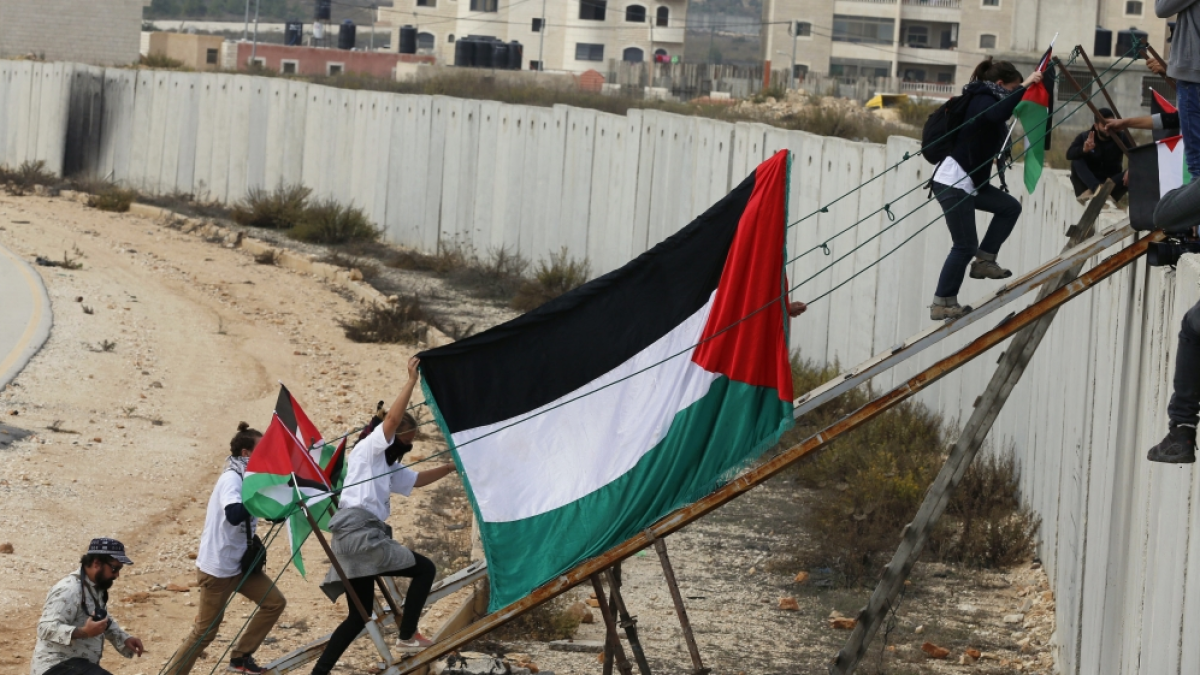When the Second Intifada, the Palestinian resistance movement against Israel in the Palestinian Territory, began in 2000, Israel started building a wall in the Palestinian Territories with the claim of protecting Israel from terrorist attacks.[1]By resolution ES-10/14, the United Nations General Assembly (UNGA) requested an advisory opinion from the International Court of Justice (the Court) on the legal issues surrounding the wall constructed by Israel in and around East Jerusalem.These issues concern Israel’s obligations as the Occupying Power in the Occupied Palestinian Territory under international law including the Fourth Geneva Convention 1949.
After resolving the contentions to its jurisdiction to give an advisory opinion on the issue, the Court reviewed the relevant rules of international law and analysed whether there would be a violation deriving from the construction of the wall.
I. The status of Israel as the Occupying Power[2]
The Armistice Agreement between Israel and Arab forces established a demarcation line between Jordan and Israel, also known as the Green Line.[3]The then eastern border of Palestine and the Green Line was occupied by Israel in 1967 as a part of the conflicts that arose between Jordan and Palestine. Accordingly, this area including East Jerusalem, Israel previously had the status of Occupying Power under customary international law.
II. Relevant rules of International Law
1. United Nations Charter and UNGA Resolution 2625 (XXV)[4]
a.Threat or use of force:Article 2 (4) of the Charter of the United Nations (UN Charter) prohibits threat or use of force by states. The UNGA Resolution 2625 (XXV) (Resolution 2625) underscores the impossibility of acquisition of territory by threat or use of force, which if acquired in such a way will be recognized as illegal. The principles on the threat or use of force are recognized as a part of customary international law and this also holds for the illegality of the acquisition of territory via threat or use of force.
b. Self Determination of peoples:According to the UN Charter and Resolution 2625, states have a duty to not resort to forcible action that deprives people of their right to self-determination. This right and the obligation to respect, it is reinforced by common article 1 of the International Covenant on Economic, Social and Cultural Rights (ICESCR) and the International Covenant on Civil and Political Rights (ICCPR). The right is applicable to all territories, including non-self-governing ones, and is a righterga omnes.
2. International Humanitarian Law[5]
The Court found that; the Hague Regulations, as a part of customary international law, and the Fourth Geneva Convention, to which Israel and Jordan are a party, are applicable in the Palestinian territories occupied by Israel during the 1967 conflict. Under Article 2 (2) of the Fourth Geneva Convention, protection is granted to civilians “who find themselves…in the hands of the Occupying Power…”, as is the case of Palestine.
3. Human Rights Law[6]
Israel is a party to human rights treaties namely ICCPR, ICESCR, and the Convention on the Rights of Child (CRC). Human rights law continues to apply in times of armed conflict, so long as international humanitarian law does not applylex specialis.The Court finds that these treaties are applicable in the Palestinian territories, as they also apply in the case of exercise of state jurisdiction (Israel) outside of its own territory (in the Palestinian Territories.)
III. Violation of International Law[7]
1. Israeli settlements in the Palestinian territories[8]
The Court found that the policy of Israel, which led to the establishment of Israeli settlements in the Palestinian territories is a violation of Article 49 (6) of the Fourth Geneva Convention. This prohibits the Occupying Power from transferring its own population to the Occupied Territories. The United Nations Security Council also underscores that these are a “flagrant violation” of the Fourth Geneva Convention.
2. The Characteristics of the wall[9]
The Court stated that the possibility of the wall becoming permanent is equal to ade factoannexation and it does not matter whether Israel claims it to be temporary protection for terrorist attacks.
The route of the wall and the risk of potential changes in the configuration of the wall that might cause the Palestinian population to leave their current residence, preventing Palestinian people from exercising their right to self-determination.
3. The Consequences of the Construction of the Wall[10]
During its construction, certain properties have been destroyed or appropriated, which violates Articles 46 and 52 of the Hague Regulations of 1907 and of Article 53 of the Fourth Geneva Convention that protects the property in the Occupied Territories from the Occupying Power.
The wall creates a “closed area” and thus would create obstacles to the freedom of movement of the Palestinians, agricultural production, access to services of health, education, and water sources. The wall, taken in conjunction with the Israeli settlements, also affects the freedom of Palestinians to choose residence. Consequently, the wall would violate the liberty of movement enshrined in Article 12 (1) of ICCPR, the right to work, to health, to education, and to an adequate standard of living guaranteed by ECCPR and CRC.
The Court found that protection accorded under international humanitarian law and human rights law cannot be justified by the relevant provisions under the respective treaties (i.e., military necessity or exceptions for derogation), since Israel failed to prove that the wall is required for security reasons.
Consequently, the wall would lead to the violation of Israel’s obligations under international humanitarian law and human rights instruments.
4. Circumstances precluding wrongfulness under International Law[11]
The Court noted that Israel may not rely on Article 51 of the UN Charter because there is no armed attack attributable to a foreign State. The state of necessity under customary international law may also not be invoked since the construction of the wall is not the only way to safeguard the interests of Israel against a “grave and imminent” peril.
IV. Legal Consequences of Violations[12]
Israel has the obligation; to comply with international law, to cease the violations caused by the construction of the wall and to compensate the damages of natural or legal persons due to the construction of the wall.
Some of the rights and obligations relevant to the construction of the wall have anerga omnescharacter and thus, all states are obliged to recognise the situation as illegal and not aid the construction in any way: The UN should further deliberate on the actions to be taken to put an end to the situation.
V. Some of the Separate Opinions and Declarations
Separate opinion of Judge Koroma:[13]The judge added specifically that the Occupying Power violates its obligation to not make changes in the status of the Occupied Territory. Also, the judge stressed that the wall would violate the Palestinian right to self-determination including the right to establish a state: recognized by Resolution 181 (II) of 29 November 1947.
Separate opinion of Judge Koojimans:[14]The judge states that the act of Israel must be put through a proportionality test required by military necessity. The judge also claims that an armed attack does not have to be an act of a foreign State but an act of international terrorism in a territory under Israeli control.
Declaration of Judge Buergenthal:[15]According to the judge, the invocation of self-defense may also be in the face of an attack coming from an entity other than a foreign State.
Separate opinion of Judge Elaraby:[16]The judge adds that Israel should respect the territorial integrity of the Occupied Palestinian Territory and underlines that the Court stated in the cases ofSouth West AfricaandNamibiathat former mandatory territories were “not to be annexed.”The judge also draws attention to the rules of ensuring protection to non-combatants injus in belloand suggests that the breaches by Israel under international humanitarian law should be characterized as “grave breaches”.
VI. Conclusion
The Advisory Opinion is not binding, and it did not stop the wall from being constructed. The wall added substantially to the violence in the region. However, the findings of the Court still shed a light on the legal analysis of the current conflict related to factors other than the wall. As the Court stated, human rights obligations continue to exist also in East Jerusalem during an armed conflict. This renders under ICCPR, ICESCR and CRC, the illegal use of force a violation of human rights obligations. Further, national court rulings on evictions in Sheikh Jarrah may relate to the finding of the Court in this Advisory Opinion on the obligation of the Occupying Power to not transfer the Occupied Population from the Occupied Territory. Lastly, the Court also sets a guiding analysis on how to evaluate the consequences of armed activity on civilians. Civilians are a prohibited target and any unintended consequence on them must be put through a military necessity test during an armed conflict as well as a proportionality test as added by Judge Koojimans.
Image: AlJazeera
Sources:
[1]Legal Consequences of the Construction of a Wall in the Occupied Palestinian Territory, Advisory Opinion, ICJ GL No 131, [2004] ICJ Rep 136, (2004) 43 ILM 1009, ICGJ 203 (ICJ 2004), 9th July 2004, United Nations; International Court of Justice para. 115-122 [hereafter “The Wall Opinion”]
[2]Ibid, para. 70-78.
[3]General Armistice Agreement between the Hashemite Jordan Kingdom and IsraelUN Doc S/1302/Rev.1 3 April 1949.
[4]The Wall Opinion para. 87-88.
[5]The Wall Opinion, para. 89-101.
[6]The Wall Opinion, para. 102-113.
[7]The Wall Opinion, para. 123-137.
[8]The Wall Opinion, para. 123-137.
[9]The Wall Opinion, para. 123-137.
[10]The Wall Opinion, para. 123-137.
[11]The Wall Opinion, para. 138-141.
[12]The Wall Opinion, para. 154-160.
[13]The Wall Opinion, p.204-206.
[14]The Wall Opinion, p.219-234.
[15]The Wall Opinion, p.240-215.
[16]The Wall Opinion, p.246-259.





